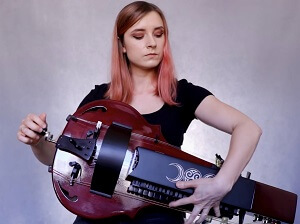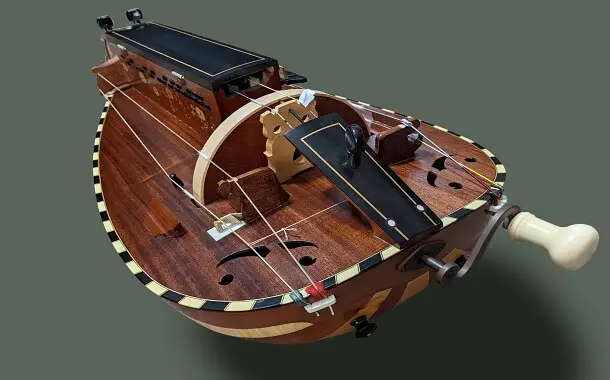How Much Does a Hurdy Gurdy Cost?
Last Updated on December 29, 2023
Written by CPA Alec Pow | Content Reviewed by ![]() CFA Alexander Popinker
CFA Alexander Popinker
The Hurdy-Gurdy, even though it has a really wonky name, is an instrument with a very spicy price tag. Aside from its high price, the hurdy-gurdy is also a rather unique instrument that you might not find in just any store.
How Much Does a Hurdy Gurdy Cost?
A new hurdy gurdy from a popular brand can cost anywhere between $4,000 and $6,000. Weirdly enough, good used hurdy gurdies will be expensive as well, with prices between $2,000 and $4,000. Even though hurdy-gurdies are far from cheap, until recently, they were known as peasant instruments.
But what makes hurdy gurdies this expensive? For starters, the manufacturing process for a hurdy gurdy is very costly. This is because this is a niche instrument that isn’t made in a factory, but by hand. Then, to make sure that it can produce its very iconic sound, the hurdy gurdy will be made of very complex and expensive mechanisms.
Even so, hurdy-gurdies are considered very underrated, being exquisite instruments. We’re going to talk more about how they are made and what they are so that you understand what makes them expensive.
The cost of wood
It’s never cheap to buy high-quality wood. But as you might have noticed, these costs have really gone up over the past several years.
It becomes harder and harder for hurdy-gurdy makers and luthiers to find wood, as timber is used intensively for furniture, paper products, homes, and so on. And of course, only certain types of wood types will do.
The wood the hurdy-gurdy is made from should be free of impurities. Spruce, beech, and hard maple are preferred. As you’d expect, these are also the types of wood that are more expensive.
Hurdy-Gurdy manufacturing
In a world full of things that come from a factory, there are very few that are still made using old-fashioned methods.
Most of the hurdy-gurdies you will be able to buy are made in niche workshops and not factories. Factory-made hurdies are called nerdy gurdy. They require a highly skilled craftsperson who knows how to refine a block of wood and turn it into the final product. This is hardly an automated process, even though some power tools will still be used.
Of course, the more moving parts an instrument has, the higher the manufacturing costs. This is another reason why this particular instrument will come at a huge price.
Supply and Demand
The obscurity of this instrument is another factor that makes it expensive. Not a lot of people know what a hurdy-gurdy is, and out of these few, even fewer will be in the market for one at any point in their lives.
The limited demand doesn’t warrant a need for mass production. Not to mention that those few hurdy-gurdy enthusiasts will be more interested in getting a one-of-a-kind instrument that can create hair-raising sounds than a low-quality factory-made product.
What are Hurdy Gurdies?
To put it simply, the unique instrument known as a hurdy gurdy is a type of hybrid between a bagpipe and a violin. Of course, things are never this simple.
Let’s first understand where its name came from.
When it first originated in France, during the medieval era, it was called a “wheel Fiddle”, or “vielle a roue”. It was only named hirdy-girdy when it reached Brittain. This was a term used at the time for commotion and noise. This makes it seem that people weren’t really in love with the instrument at first.
With a very rich history, the hurdy gurdy was first used as a church instrument, although peasants later adopted it to crank folk music and melodies. Very few people still recognize this instrument by its appearance or name.
But once you hear it, you will know for sure you’re delighted by a hurdy gurdy.
The cost of maintaining a Hurdy Gurdy kit
Owning a hurdy-gurdy is a rather unique experience. It can take you to a distant past and mythical lands with its interesting tone.
This tone is rather hard to achieve. You must take really good care of your hurdy-gurdy if you want it to achieve this magic. As it comes with a lot of moving parts, you will have to maintain them all.
If you want your hurdy-gurdy to keep sounding good, here are the most important things to do:
Applying rosin
 Violinists already know that rosin is a very important product. For those who don’t know what this is, it is a substance that influences the tone of a violin bow. It resembles a sap substance. Rosin helps with the friction, which is the only thing creating sound between the violin strings and the bow.
Violinists already know that rosin is a very important product. For those who don’t know what this is, it is a substance that influences the tone of a violin bow. It resembles a sap substance. Rosin helps with the friction, which is the only thing creating sound between the violin strings and the bow.
Rosin has to be applied on the wheel of a hurdy-gurdy. The wheel has the same job as the violin bow, acting in the same way on the strings. This is why your hurdy-gurdy can get a disappointing, dull tone if you forget to apply rosin.
Replacing the cotton
Yes, weirdly enough, cotton is used in this musical instrument. The cotton on the strings will have to be replaced if you want them to sound good as long as possible.
The hurdy gurdy has strings with a base of cotton, right where the wheel touches them. This is meant to reduce the damage caused by friction on the strings while the wheel rugs against them. It also improves the sound the instrument makes.
Cotton is fragile though, as you might know. You will need to replace it at some point to avoid causing damage to the strings. If not, you will have to replace the strings altogether.
A new set of strings will be considerably more expensive than a small amount of cotton. This is why this is one of the most important parts of the maintenance process if you want to save money.
Conclusion
A hurdy-gurdy is far from cheap. A used hurdy gurdy kit can set you back $2,000 to $4,000, with new ones being even more expensive. There are several factors that keep the price of hurdy-gurdies so high, the most important one being that they are made by hand by experienced individuals.
The low demand for the instrument due to its lack of recognition also keeps its cost high, as it is considerably less popular than violins or guitars. No demand means restricted production.


I wish more people were interested in this incredible instrument. It truly needs more focus I never seen such sound variation in a singular instrument.